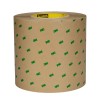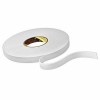The difference between normal and structural double-sided adhesive tape?
What is the difference between normal and structural double-sided adhesive tape? Of course, from the outside looking in, it wouldn’t be obvious that the world of double-sided tapes would be so rich and diverse.
For example, there are those who spend their whole lives believing that double-sided adhesive tape is that small roll that used at Christmastime to attach bows to gifts, without needing to use a “ring” of regular tape.
But that is just one of the many types of industrial double-sided tape, as well as the weakest and least impressive. There are, in fact, double-sided adhesive tapes on the market meant for the most diverse uses, which vary both in the kind of medium used – and therefore in the material placed between the two adhesive sides – and in the type of adhesive used itself.
With the variation offered by these two elements, as well as with the changes in size and thickness, the kind of strong double-sided adhesive tape completely changes too, which in the case of higher performance rolls becomes a phenomenal ally as much in industry as in construction.
When we talk about particularly strong tape, as you may have noticed when browsing the pages of our online store, we mean structural or semi-structural double-sided tape. But what does that mean?
And what’s the difference between normal and structural double-sided adhesive tape? Let’s see when it’s possible to use this term to qualify double sided adhesive tape.
The difference between normal industrial double-sided adhesive and structural double-sided adhesive: starting from the adhesives
To understand what differences exist between normal and structural double-sided adhesives, it is a good idea to start from the peculiarity of structural adhesives, that is, those adhesives generally sold in paste form which have developed since the middle of the past century in the aerospace industry.
As it is well known, in fact, there are many new technologies which had been created specifically for an aerospace use and then became everyday staples: think of in-ear thermometers (stemmed from NASA infrared thermometers), wireless instruments, cushioned shoe soles, scratch-resistant lenses (originally made for astronauts’ helmets’ glass) and so on.
Structural double-sided tape is part of this large group. In fact, this category collects adhesives able to withstand great mechanical strain, capable of replacing classic joining methods through the use of nails, screws, rivets, and welds.
But why is the conversation about structural adhesives and, therefore, also about structural double-sided adhesives? Truthfully, structural adhesives include adhesives of a very different design.
The common factor is precisely the high mechanical performance, provided by the ability of the adhesive to become a “structural” part of the material on which it is applied, thus becoming more resistant to vibration as well.
As said before, there are different types of adhesives used to achieve structural bonding, such as: acrylic resins, epoxy resins, or polyurethane resins.
Structural double-sided and normal double-sided adhesive tapes
As it has been established, there are double-sided adhesives with different mechanical capabilities and, as we have observed, structural double-sided adhesives stand out for their applications in the construction and industrial fields.
However, this does not mean, it should be stressed, that only structural double-sided adhesive tapes are utilized in these fields: in fact, there are also many other high-performance double-sided adhesives, even if they are not stated as being structural by their respective producers.
An example of structural double-sided tape
A typical example of structural double-sided tape is 3M’s VHB 4936 tape, available in our online store in 5 different widths, from 9mm to 25mm (0.03 to 0.09 in).
This is a structural double-sided adhesive made from acrylic foam with closed cells, which is sensitive to pressure. Thanks to its structure it is highly conformable and effective even on surfaces that are not perfectly homogeneous, adhering and “melding” in the places where the material shows roughness.
Specifically, in this case, 3M presents as ideal the use of this structural double-sided adhesive tape not only on aluminium, stainless steel, galvanized steel, composites, plastics, acrylic, polycarbonate, and ABS, but also on painted and sealed wood, as well as on cement.







